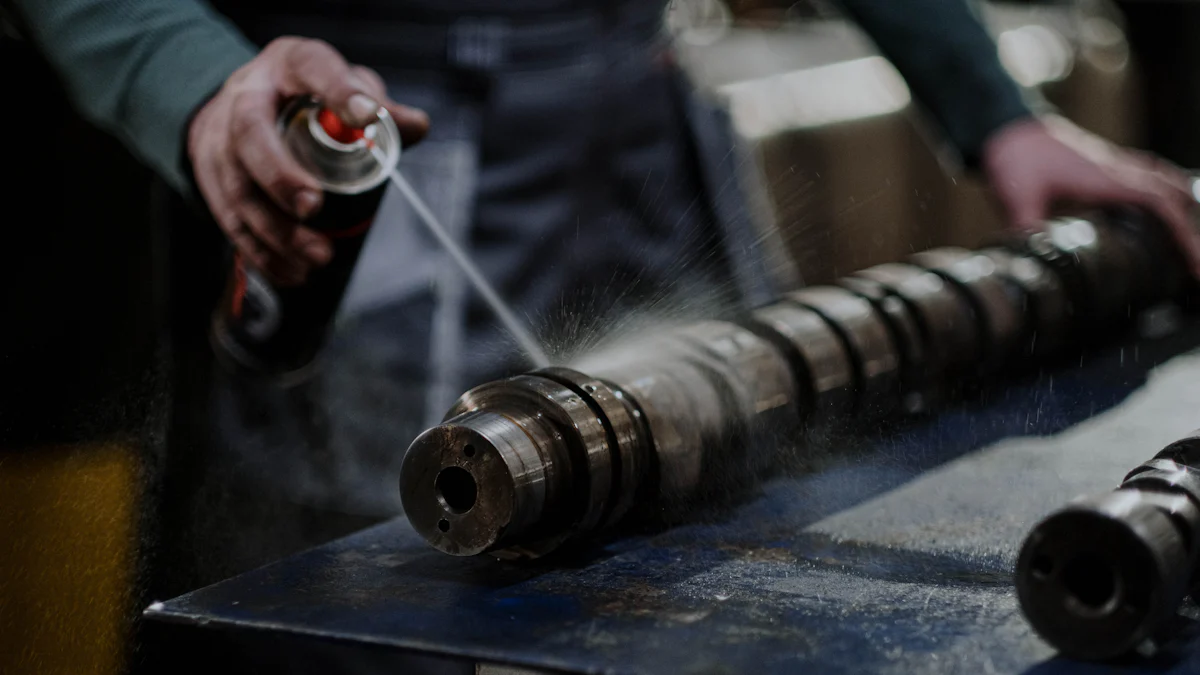
Stainless Steel Precision Casting plays a crucial role in modern manufacturing. Industries like automotive and aerospace rely on its ability to create durable, high-precision components. Companies such as Ningbo Pingheng Machinery Co., Ltd. utilize High Precision Investment Casting to craft parts from materials like Silicon Brass Precision Casting and stainless steel, supporting sustainability by reducing waste and utilizing recycled materials. Additionally, the production of Lost Wax Casting Parts further enhances the versatility and efficiency of these manufacturing processes.
Understanding Stainless Steel Precision Casting
What Is Stainless Steel Precision Casting?
Stainless steel precision casting is a manufacturing process that creates highly detailed and accurate components. It’s also known as investment casting or lost wax casting. This method uses a wax pattern to form a mold, which is then filled with molten stainless steel to produce the final part. The process is widely used because it delivers exceptional precision, durability, and surface finish.
Companies like Ningbo Pingheng Machinery Co., Ltd., established in 1999, specialize in this process. They use medium-temperature wax and work with materials such as stainless steel 304 and 316, as well as copper alloys like tin bronze and silicon brass. Their expertise allows them to meet various national standards and provide high-quality solutions for industries like automotive, engineering machinery, and shipbuilding.
Key Steps in the Casting Process
The stainless steel precision casting process involves several key steps:
- Master Pattern Creation: A wax duplicate of the desired part is made, often using 3D printing for accuracy.
- Wax Pattern Production: Wax is injected into a mold cavity to create multiple patterns.
- Tree Assembly: These wax patterns are assembled into a tree-like structure for batch production.
- Shell Building: The wax tree is coated with ceramic slurry and sand to form a strong shell.
- Dewaxing: The wax is melted and removed, leaving a hollow ceramic mold.
- Sintering: The ceramic mold is heated to strengthen it.
- Casting: Molten stainless steel is poured into the mold.
- Cooling and Solidification: The metal cools and hardens.
- Shell Removal: The ceramic shell is broken away to reveal the cast part.
- Post-Processing: The part undergoes machining and finishing to meet specifications.
Why Stainless Steel Is Ideal for Precision Casting
Stainless steel offers unique properties that make it perfect for precision casting. Its strength, flexibility, and resistance to extreme conditions set it apart from other materials. For example:
- It produces intricate and highly detailed components.
- It provides excellent dimensional accuracy and surface finish.
- It resists corrosion, ensuring durability in harsh environments.
- Various stainless steel alloys, like 304 and 316, can be tailored for specific applications.
A comparison of stainless steel alloys highlights their versatility. For instance, stainless steel 304 is highly formable and corrosion-resistant, while 316 excels in chloride-rich environments. These qualities make stainless steel precision casting indispensable for industries requiring high-performance parts.
Benefits of Stainless Steel Precision Casting
High Precision and Complex Design Capabilities
Stainless steel precision casting excels in creating intricate and detailed components. This process allows manufacturers to achieve designs that are otherwise challenging to produce. For example:
Stainless steel casting allows for intricate designs. Manufacturers can create shapes that are hard to achieve otherwise. This precision helps make unique products. Using stainless steel also ensures the designs are strong. The casting process maintains the needed strength in complex shapes.
Some common applications include:
- Pump housings, valves, and fittings for chemical and petrochemical industries.
- Surgical tools, implants, and sanitary components for food processing.
- Architectural hardware and structural supports.
In industries like aerospace and automotive, this method produces lightweight, durable parts that enhance performance and safety. The ability to replicate complex shapes with high accuracy makes stainless steel precision casting indispensable for modern manufacturing.
Durability and Corrosion Resistance
Stainless steel components are known for their exceptional durability and resistance to corrosion. Several factors contribute to this, such as:
- Chloride Concentration: Stainless steel resists damage from chloride ions, making it ideal for marine and chemical environments.
- Oxygen Availability: Oxygen-rich conditions help maintain its protective layer, ensuring long-term durability.
- Mechanical Stress: Even under stress, stainless steel resists cracking in corrosive settings.
Industries like marine, oil and gas, and food processing benefit significantly from these properties. For instance, marine applications use grade 316 stainless steel to withstand saltwater corrosion, while food processing relies on grades like 304 for hygiene and resistance to food acids.
Cost-Effectiveness and Reduced Material Waste
Stainless steel precision casting offers cost-saving advantages, especially in large-scale production. While the initial investment may seem high, the long-term benefits outweigh the costs. This process minimizes material waste by utilizing recycled materials and producing components with fewer defects. Additionally:
- Mass production becomes faster and more efficient.
- Longer-lasting products reduce the need for frequent replacements.
- Competitive pricing becomes achievable, boosting profitability.
By reducing waste and optimizing production, stainless steel precision casting supports both economic and environmental goals.
Contribution to Sustainable Manufacturing Practices
Sustainability is a growing priority in manufacturing, and stainless steel precision casting plays a vital role. Foundries now adopt eco-friendly practices, such as:
- Using recycled materials to conserve natural resources.
- Replacing traditional materials with biodegradable wax patterns and water-based ceramic slurries.
- Implementing energy recovery systems to capture and reuse heat, reducing energy consumption.
Ningbo Pingheng Machinery Co., Ltd., established in 1999, exemplifies this approach. By using investment casting with medium-temperature wax, they provide high-quality solutions for industries like automotive, engineering machinery, and shipbuilding. Their use of materials like stainless steel 304 and 316 aligns with sustainable practices, ensuring durability and reduced waste.
Applications of Stainless Steel Precision Casting

Automotive and Aerospace Components
Stainless steel precision casting plays a vital role in manufacturing critical automotive and aerospace parts. This process enables the creation of complex shapes and high-precision components, which are essential for safety and efficiency. For example:
- Engine parts
- Fuel system parts
- Cabin control systems
- Hydraulic systems parts
- Environmental controls
- Landing systems
In aerospace, lightweight yet durable components improve fuel efficiency and reduce emissions. Similarly, automotive manufacturers rely on this technology to enhance vehicle performance and meet environmental standards. By producing intricate and reliable parts, stainless steel precision casting ensures these industries stay innovative and competitive.
Medical and Healthcare Equipment
The medical field demands precision and reliability, and stainless steel precision casting delivers both. It’s used to manufacture items like:
- Surgical instruments
- Implants
- Diagnostic equipment
This process ensures components meet strict hygiene and safety standards. For instance, surgical tools and implants require exceptional accuracy to maintain patient safety. Stainless steel’s corrosion resistance and durability make it ideal for medical applications, ensuring equipment remains reliable over time.
Industrial Machinery and Tools
Industrial machinery benefits significantly from stainless steel precision casting. Commonly produced items include:
- Pump housings
- Valves
- Fittings
- High-performance turbine blades
- Engine housings
Stainless steel’s strength and resistance to wear and tear enhance the durability of these tools. This reduces the need for frequent repairs, saving time and money. By improving production efficiency and product quality, stainless steel precision casting drives innovation across various manufacturing sectors.
Energy and Power Generation Solutions
Energy industries rely on stainless steel precision casting for its ability to withstand extreme conditions. Applications include:
| Energy Sector | Application Description |
|---|---|
| Oil and Gas | High-strength, corrosion-resistant materials for performance-critical applications. |
| Nuclear Power | Components that endure extreme temperatures and pressures. |
| Renewable Energy | Durable parts for wind turbines, solar panels, and hydroelectric systems. |
Stainless steel components ensure reliability and longevity, even in challenging environments. For example, Alloy 718 is often used in gas turbines due to its high-temperature capabilities. This technology also supports renewable energy advancements by providing corrosion-resistant parts that enhance efficiency and sustainability.
Ningbo Pingheng Machinery Co., Ltd., established in 1999, exemplifies excellence in this field. Using investment casting with medium-temperature wax, they produce high-quality solutions for industries like automotive, engineering machinery, and energy. Their expertise in materials like stainless steel 304 and 316 ensures components meet diverse national standards.
Stainless Steel Precision Casting remains a cornerstone of modern manufacturing. Its ability to produce durable, precise, and sustainable components drives innovation across industries. Companies like Ningbo Pingheng Machinery Co., Ltd., established in 1999, exemplify excellence by using investment casting with medium-temperature wax to deliver high-quality solutions for automotive, energy, and engineering sectors.
This process enhances production efficiency, reduces waste, and supports sustainability. Its versatility ensures applications in diverse fields, from aerospace to medical equipment. As manufacturing evolves, advancements like 3D printing and energy-efficient methods will further elevate its importance. Stainless Steel Precision Casting will continue shaping the future of industrial innovation.
FAQ
What industries benefit the most from stainless steel precision casting?
Stainless steel precision casting supports industries like automotive, energy, engineering machinery, and shipbuilding. Companies like Ningbo Pingheng Machinery Co., Ltd. provide tailored solutions for these sectors.
How does stainless steel precision casting contribute to sustainability?
This process reduces waste by using recycled materials and biodegradable wax patterns. Ningbo Pingheng Machinery Co., Ltd. adopts eco-friendly practices to meet modern sustainability goals.
What materials are commonly used in stainless steel precision casting?
Manufacturers like Ningbo Pingheng Machinery Co., Ltd. use stainless steel 304, 316, tin bronze, and silicon brass. These materials meet various national standards for durability and performance.
